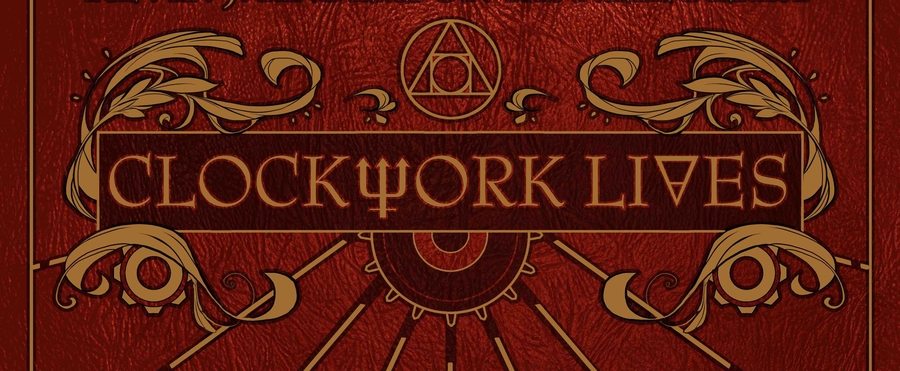Published in 2015, Clockwork Lives is a companion piece to a world inspired by a rock band’s album. Isn’t that the coolest premise for a novel you’ll ever read? From what I understand, both Clockwork Angels and Clockwork Lives seek to provide a narrative created from Rush’s album of the same name. Unfortunately, gamobo has no room for music in its title, and so I’ll only be talking about one of the books here.
I picked up Clockwork Lives at my library because it was propped up on a shelf and had an interesting hardcover binding. After reading the first few pages, I was attracted to the light-hearted narrative, as well as the promise of a steampunk world. Most depictions of steampunk is Victorian and dreary, with grey buildings obscured by pollution and fog, but this novel begins by painting a world full of colour, beautiful trains, and golden cities and airships. I was interested in seeing more of this world.
Therefore, while this review will follow standard gamobo-reviewing procedure, for this title there’ll be a fourth section: World Building, because for fantasy novels, this element of a story can be distinguished from the Narrative, and Clockwork Lives has given me good reason to consider it as such.

Plot
The main story follows a woman named Marinda Peake, who is bequeathed upon her father’s death a special alchemy book that records people’s lives when their blood touches its pages. She is tasked with filling the book with interesting stories, and so she must venture away from her comfortable little Lugtown.
While the main plot follows Marinda as she gathers her tales, the heart of the story lies in the various short stories we get from a multitude of characters. This novel is more like a collection of stories, meant to be enjoyed one at a time, and it works because it doesn’t fall into the trap of having a boring narrative that holds it all together. Marinda’s story is just as interesting, and we want her to succeed as we see her learning and growing from the stories she gathers.
My two favourite stories were the percussor’s and the strongman’s. Just about every story was interesting and engaging, but these two stood out for me because the characters within them were fully developed. These are two great examples of how to make very interesting characters in a short amount of time.
While not technically a coming-of-age story, Clockwork Lives is similar in that it is a story about a character who starts out believing she has everything she needs, but discovers everything that she lacks. One of the main themes is that while some lives are short sentences, others are epics, and we have a choice as to what ours will be. It’s a neat little message, and the plot emphasizes this point effectively and meaningfully, with all the stories of adventure contained within.
Characters
Since this is a story about stories, just about every character is given a brief moment in the spotlight before the plot moves on to the next.
But that isn’t to say that any of the characters are weak. Each character delivers a story that helps to unveil more of this fantasy world and its rules, and some of the characters you can’t help but wish you knew more about, such as the bookseller.

Interestingly enough, we don’t get the story of the most captivating character of them all: the Watchmaker. He is the head honcho of this steampunk world, the supreme leader able to transmute gold. He affects several of the characters’ lives, and I was really looking forward to getting a drop of his blood in order to read his story (which would’ve subsequently explained his motives and the creation of this novel’s world), but that never happens. I’m disappointed, to be sure, but I suspect this was the right way to go. Best to leave Albion and its history up to the readers’ imagination.
As our protagonist, Marinda Peake fulfills her role adequately. She is by no means a hero or a prime mover, but it is because of her that we are getting all of these stories, and that’s good enough. Her transformation from content caretaker to adventurous storykeeper is convincing and pleasant. All the exciting stuff happens to other characters, and except for a brief spelunking foray, Marinda is never really put into danger or called upon to save the day, and that’s perfectly fine. This book accomplishes its primary goal (entertaining the reader) in its own way, and I think most readers will be able to recognize that.
Narrative
The prose is light and charming for the mos part, with nice little zingers of philosophical one-liners eloquently stated here and there. If I had to be picky, I’d say the story overuses the one sentence paragraph, and there were a high number of errors and awkward phrasing (shame on the editor). I’m not sure if this is standard for first-round printings, but there it is.
Every time Marinda collects another story, the book switches into a first-person narrative of whoever’s stories it belongs to. It would’ve been nice to get a more varied narrative in these instances, with accents and differences in expressions. As it is, all the narratives feel similar to one another in the way they read. Though the content is sufficiently different to distinguish them apart, it still feels as if one speaker is telling all the stories, and given the nature of how Clockwork Lives presents itself, it would’ve been more immersive if more effort was put into distinguishing each storyteller’s voice. The most successful example is the percussor, and I suspect Mr. Peart had a greater hand in that story’s telling.
The main narrative is good enough to prop the story up and keep it rolling, however, and so it never gets in the way of enjoying the stories. Everything is clear and demonstrates impressive descriptive, allusory, and metaphorical technique.
World Building
Perhaps this is a section I will add to all future fantasy book reviews. The world itself is, after all, a very important part of fantasy stories. It moderates the reader’s suspension of disbelief, and depending on the writer’s abilities, it can potentially be more real than the real world.
The world of Albion is gorgeous, with Crown City representing the pinnacle of polish, order, and cleanliness. Picture a golden city where clockwork angels emerge from the central watchtower and fly about to the adoration of the masses below, the entire scene bathed in the orange glow of a beautiful sunset. The imagery contained in this book is provoking, whether it was a streamliner traveling under a star-filled sky or a quiet little bookshop tucked away in an alley.
The premise of the story gave the author the perfect excuse to paint a host of settings and places, and each opportunity was taken with success. Every setting feels like it belongs in the world, which is familiar but also filled with magic and alchemy. Steampunk doesn’t always have to be representative of industry, pollution, or poverty, and Clockwork Lives proves it. This world is filled with bright and cheerful people, set in beautiful places and interesting sights. It was easy for me to picture the scenes in the book, and the words only helped to build the image in your head piece by piece, while leaving enough room for you to fill it in with grandeur and magnificence.
In Conclusion…
Clockwork Lives is a great fantasy novel. It’s short and sweet, though you may want to go in expecting a collection of short stories rather than one large narrative. Each story is interesting and contributes to the construction of the world it takes place in, which is how the book feels unified and complete by the end.
You may or may not be moved to start an adventure on your own after reading this book, but Marinda’s own adventure is interesting enough to keep you distracted for a while. I recommend this book to any fan of fantasy of any age. It is well written for the most part, and takes itself seriously enough to force the reader to do the same as well.
This has been a gamobo review.

One thought on “Book Review – Clockwork Lives by Kevin J. Anderson & Neil Peart”